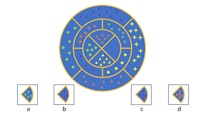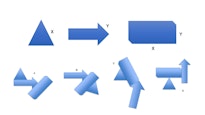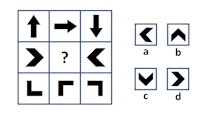Air Traffic Control (ATC) Tests (2025 Guide)
All products and services featured are independently selected by WikiJob. When you register or purchase through links on this page, we may earn a commission.
- Air Traffic Control Background Knowledge
- ATC Tests: What Are They?
- How Long Is the AT-SA Exam?
- What Is the Format of the ATC test?
- Tips on How Can You Prepare or and Pass the Air Traffic Control Test?
- What Questions Could Be Included in the ATC Tests in 2025?
empty
empty
empty
empty
empty
empty
empty
- Final Thoughts
NATS, the UK’s leading and most comprehensive provider of ATC employment requires approximately 200 air traffic control (ATC) trainees a year on average.
An ATC enables the smooth running of air traffic, both on the ground and in the sky.
The job requires a particular set of skills, calm nature and complete commitment.
It is a career that consistently offers the opportunity to develop. There are many incentives to join NATS, and controllers are highly valued.
There is an extensive recruitment and selection assessment process. The right preparation, practice and knowledge will increase your chances of scoring highly.
Higher scores will mean being sought after more by employers.
The initial assessment is typically an ATC aptitude test, and there are free practice tests to help you prepare, making the ATC test prep process more accessible for aspiring air traffic controllers.
Air Traffic Control Background Knowledge
It is worth conducting extensive research before applying for the ATC assessment process.
Having background knowledge will help in the aptitude tests as you will be able to relate to why and what is being asked of you.
ATC Tests: What Are They?
The ATC aptitude test aims to find out which potential candidates are likely to succeed through all stages of training and development to become an air traffic controller.
It tests how the candidate would cope under pressure and tests decision-making and cognitive skills.
NATS currently employs 1,670 controllers at 13 airports across the UK. Many candidates will apply for their ATC tests through NATS.
NATS has an extensive process that the hopeful recruit has to go through before being selected
This includes:
- The aptitude tests
- Two-stage online assessments
- Attending an assessment centre
- College training
Each provider’s ATC tests will vary, but commonly, it measures through psychometrics.
The air traffic controller tests could include:
-
Numerical Reasoning – It is important to test numerical reasoning, for as a controller will need to analyse and interpret numerical information given in tables and charts and make decisions based on this.
-
Verbal reasoning – The verbal reasoning test for ATC measures the applicant’s understanding and comprehension skills. This is necessary for the role as the controller will need to listen to instructions and act on them immediately.
-
Abstract reasoning – Abstract reasoning considers the ability to recognise and analyse patterns, figures, and data without prior knowledge. For an air traffic controller, these skills are important, as the role requires the controller to find and recognise certain data to make decisions with, as well as recognise problems and solve them.
-
Spatial reasoning – This test means looking at a pictorial image, such as a map, plan, or diagram, and understanding it to the point of visualisation. An ATC would need to look at diagrams and a map of the airspace, visualise what is happening and ascertain whether it is safe for an aircraft to fly in that space.
-
Deductive reasoning – A deductive reasoning test measures the candidate’s ability to think. There is no guessing in this test. This is important to the everyday role of a traffic controller who needs to make the right decision quickly with the information they have.
-
Inductive reasoning – Inductive reasoning is the opposite of deductive in that there may be a more general answer, rather than a specific one. For an ATC, this shows their ability to take on new situations combined with their confidence to apply their findings.
-
Situational judgement – In the situational judgement tests, the candidates are given a scenario with multiple solutions. The test measures how the candidate judges and tries to solve this situation.
-
Personality – The role of an air traffic controller requires resilience, a can-do attitude and a need to remain calm. This is why part of the aptitude test can include a personality test. It will analyse if the candidate has the right personality traits listed above through several questions.
Practice Air Traffic Control Tests with JobTestPrep
How Long Is the AT-SA Exam?
The Air Traffic Skills Assessment (AT-SA) exam is a computer-based test used by the Federal Aviation Administration (FAA) to assess candidates for air traffic control (ATC) positions.
The duration of the AT-SA exam can vary depending on the specific version and components of the test.
However, on average, the exam takes approximately 2.5 to 3 hours to complete.
What Is the Format of the ATC test?
The ATC test, specifically the AT-SA exam, consists of multiple sections designed to evaluate different skills and abilities required for air traffic control. The specific format may vary, but here are some common components of the AT-SA exam:
- Biographical Assessment: This section collects personal and background information from candidates.
- Cognitive Ability Assessment: The cognitive ability section measures various cognitive skills such as problem-solving, mathematics, pattern recognition, and spatial reasoning. It assesses your ability to process and analyze information quickly and accurately.
- AT-SAT Simulation: The Air Traffic Skills Assessment Test (AT-SAT) simulation assesses your ability to manage simulated air traffic scenarios. It includes tasks such as traffic sequencing, separation management, and communication skills.
Tips on How Can You Prepare or and Pass the Air Traffic Control Test?
Passing the ATC test requires preparation and a solid understanding of the skills and knowledge needed for air traffic control. Here are some tips on how to study for air traffic control test:
-
Study the Material: Familiarize yourself with air traffic control concepts, procedures, and regulations. Review resources provided by the FAA, such as the Air Traffic Control Handbook and the ATC pre-employment preparation guide.
-
Practice ATC Scenarios: Obtain practice materials or use online resources that simulate air traffic control scenarios. Practice managing simulated traffic, making quick decisions and prioritizing tasks.
-
Improve Cognitive Skills: Enhance your cognitive abilities, such as critical thinking, problem-solving, spatial awareness and multitasking. Engage in activities and exercises that challenge and sharpen these skills.
-
Develop Communication Skills: Effective communication is crucial for air traffic controllers. Practice concise and clear communication, both verbally and in writing. Work on your listening skills and ability to comprehend and respond accurately and promptly.
-
Time Management: The ATC test often includes time-limited tasks. Practice managing your time efficiently and making quick, well-informed decisions under pressure.
-
Be Familiar with ATC Terminology: Learn and understand the common terminology used in air traffic control. This will help you navigate the test scenarios and communicate effectively.
-
Stay Calm and Focused: During the air traffic control test, maintain composure and remain focused. Stay attentive to details, follow instructions carefully, and manage stress effectively.
It's important to note that the ATC test is competitive, and the specific requirements and components may vary based on the country and organization conducting the assessment.
Understanding the specific requirements of the test you are taking and adequately preparing for it will increase your chances of success.
What Questions Could Be Included in the ATC Tests in 2025?
NATS and other providers advise practice and preparation for the air traffic controller test, and there are plenty of free and paid tests online.
Before applying for the air traffic controller practice test, it would be worth looking at some examples questions for each section:
Numerical Reasoning Test
The numerical reasoning test is usually timed and multiple-choice.
To get an idea of the question types, here is an example of what could be included:
Example question:
Isobel’s class of 13 pupils all received an average of 85% on their history exam collectively. William scored 100%.
If William is removed from the collective results, what would the new average be?
Verbal Reasoning Test
The verbal reasoning test is likely to be screened and can be like a comprehension exam.
The candidate will be given a short passage, and then there will be a group of statements where they will need to answer true or false.
It could also test grammar, vocabulary and word analogy.
Example question:
All Drinks Co. has reported increased revenue for this quarter and put this down to an increased demand for sports drinks.
It also reported a rise in tea and coffee sales, driven by the growth of new trends on social media sites such as Instagram.
Fizzy drink sales declined 2%; while fruit-based drinks and milkshakes declined 1%.
Fizzy drink sales have been decreasing for some time as consumers have turned to bottled water and sports drinks.
Soda sales have decreased over the past decade as consumers have become more health-conscious.
a) True
b) False
c) Uncertain
If you need to prepare for a number of different employment tests and want to outsmart the competition, choose a Premium Membership from JobTestPrep.
You will get access to three PrepPacks of your choice, from a database that covers all the major test providers and employers and tailored profession packs.

Abstract Reasoning Test
Abstract reasoning is timed online and tests problem-solving and the ability at learning new skills.
Example question:

Choose what pattern should be in the empty space.
Spatial Reasoning Test
Spatial reasoning contains no mathematical or language questions, meaning background and education is irrelevant. Intelligent people learn quickly and can easily pick learn new skills. This is what this test looks at.
Example question:

In which figure are the shapes combined correctly?
The provider will conduct a deductive reasoning test to see how well the potential recruit can process information and then deduce the answer from it.
An air traffic controller needs to be logical, and so this online timed assessment will test for that.
Example question:
- Some squares are parallelograms
- Some parallelograms are rectangles
- All squares are rectangles
If the first two statements are true, the conclusion must be:
a) True
b) False
c) Uncertain
Inductive Reasoning Test
The inductive reasoning test is used in the ATC test to assess how a future employee could use observations to make intelligent conclusions or answers.
Example question:

Which option completes this matrix?
Situational Judgement Test
The situational judgement test is good for letting the employer see how the future employee would act in certain situations.
It measures behaviour rather than how they think.
Situational Judgement Tests are normally online, and text and videos are used to give several scenarios.
The answers are multiple-choice and required in the text.
Example question:
You are one a team-building away day, you are working with three close colleagues from the same department, and two others who work in a different part of the business.
You are asked to come up with a new design for a product. The two people you do not know have very different ideas from the rest of you, and your three close colleagues are becoming very frustrated with their unworkable ideas.
There is only an hour left, and little progress has been made.
What do you do?
a) Tactfully suggest ideas that are more in line with the brand
b) Suggest that, as a group, you create a series of criteria against which to review all of the suggestions made so far. This will ensure that all suggestions get a fair hearing
c) Suggest everyone has a say on what they suggest and ask the group of two to say how and why theirs would work
d) Ask everyone to come up with an idea and do a vote
Example question:
I like working in a team more than I enjoy working independently:
a) Strongly Agree
b) Agree
c) Uncertain
d) Disagree
e) Strongly Disagree
Preparation for ATC Tests
The mock online assessments are a great way to prepare for these tests.
These will give a good indication of how much time each section supplies a variety of possible questions, which areas you need to practice more and areas where you show strength.
By doing the mock assessments timed means seeing where to focus your study and areas of struggle.
It would also be wise to be familiar with all air traffic control background knowledge to be certain of what is expected in the role and also how you could progress in the role.
Does it have promotion opportunities? Will it involve travel? Do you need to work in a team? There are many places with this information, such as the NATS website.
Ensure you are well prepared on the day of the test, ensure you have enough sleep and eat enough breakfast.
Remember to remain calm during the tests.
Final Thoughts
An air traffic controller is a sought after and aspirational role.
The ATC tests give an insight into what is expected in the role, and show the provider if the individual is right for it.
Equally, it shows the individual if they are appropriate for the position.










